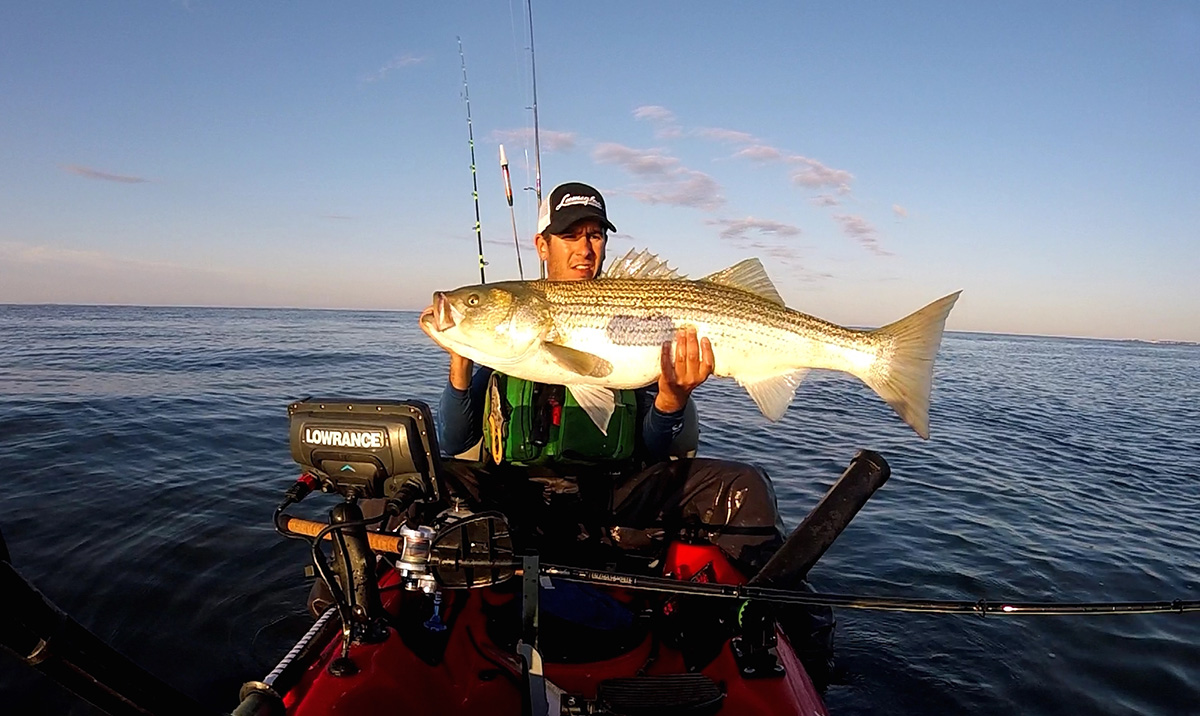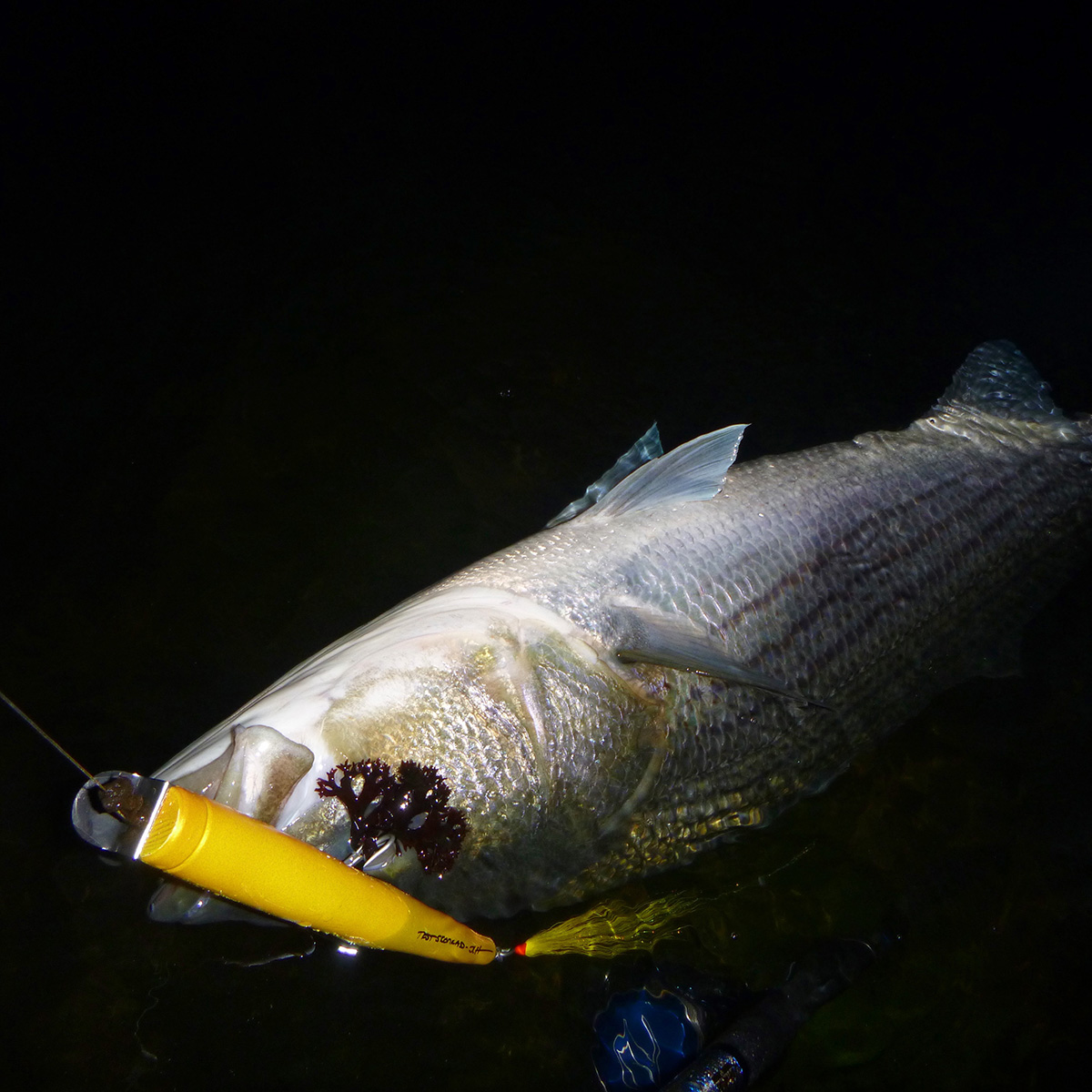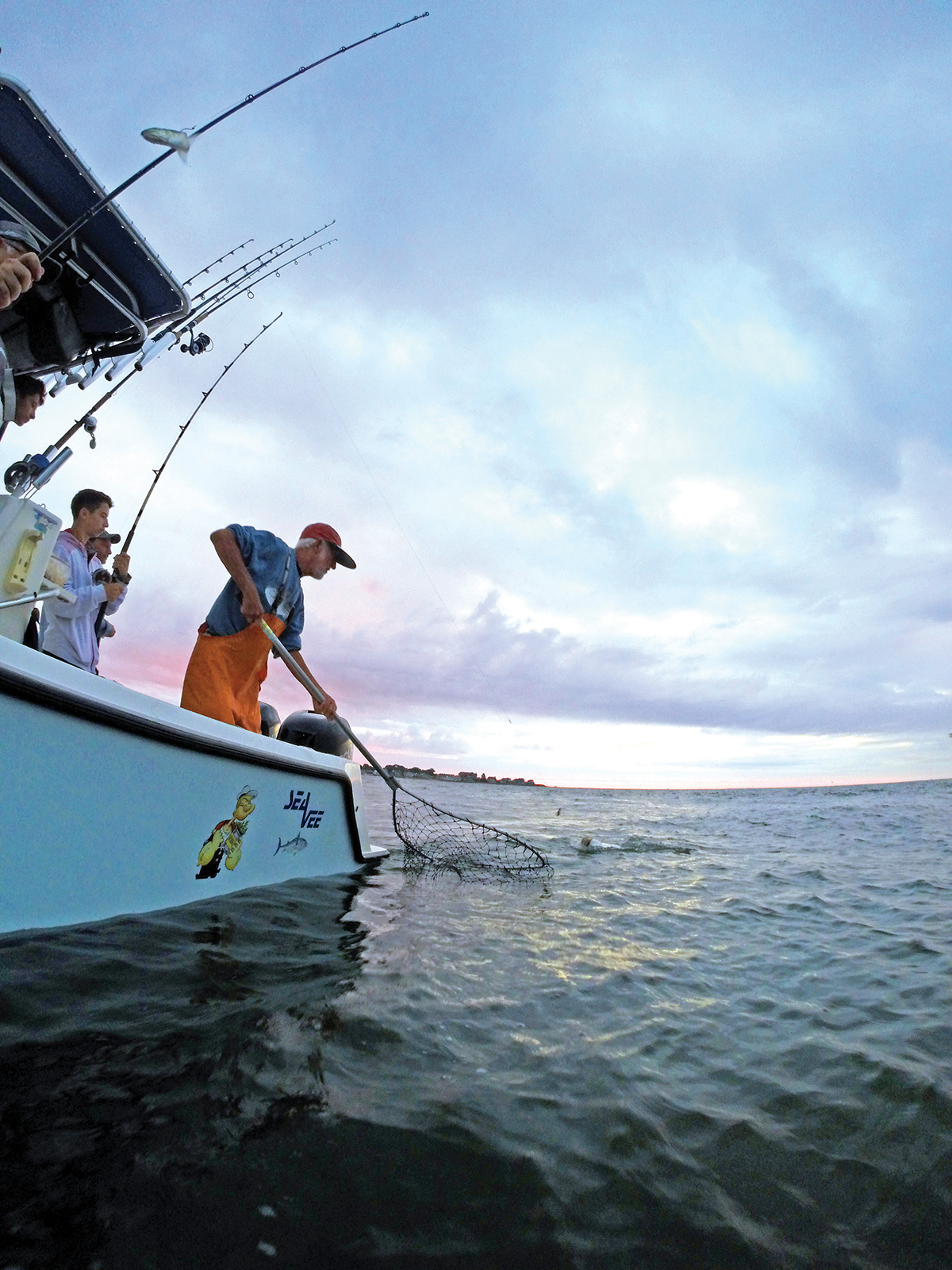
Many anglers, myself included, focus largely on rips and areas of fast-moving water when targeting striped bass. Often overlooked, eddies and areas of slower-moving water produce large stripers just as well as drifting in the rip. Since I often fish from a kayak, there are nights where fishing “the rip” just isn’t feasible due to current intensity or wind. On those nights I find myself focusing on eddies or breaks in the current caused by the rip colliding with structure. Although I first took notice of this while kayak fishing, I’ve also had great success fishing eddies while surfcasting, and now I find myself spending more time fishing them instead of just casting into a rip.
A What?
For those that aren’t familiar with “eddies,” by definition it means “a circular movement of water, counter to a main current, causing a small whirlpool.” A term regularly associated with trout fishing, a trout angler often targets the slow, circulating water along a riverbank or behind boulders in a run of rapids. Similar situations occur along the shoreline where there are areas of high current. This change in current direction occurs when the current from a rip collides with structure or land causing the eddy to form. The eddy may only occur in certain spots on one tide, sometimes only existing for a short duration of the tide depending on the changing water level or intensity of the current. Striped bass hold in these areas similar to how trout do so to avoid fighting heavy current while looking for a meal. I use the word “eddy” loosely when striper fishing since I target areas of slower water or current breaks just outside of the rip with the same techniques. There might not be a strong circulation of water but they are often easy to spot.
The easiest way to locate an eddy is to look at the down-current side of where a rip meets structure close to shore. The water deflecting off the structure will push towards shore and circulate back towards the rip. The structure could be a few big boulders, a sand bar, a jetty or even a larger reef. Areas where the rip runs off of a rocky point are always great places to target. Even if they are on the smaller side, the cove area next to most points often has an eddy and is a great area to fish. Take note of how the water flows over the structure you fish and look for any possible current breaks that could create a holding spot for fish.
I begin by targeting the seam along the edge of the rip where it meets the slower water in the eddy. The fish will regularly cruise along the edge of the rip in the slower water looking for food coming by in the rip. They also roam the slower water looking for an easy meal. I’ve noticed at times, especially when baitfish like adult bunker are not present, that the fish want the presentation right on the bottom since that seems to be where they are scavenging for food.
From a Kayak
From the kayak, my favorite technique when targeting eddies has always been weightless eels. Usually slow-trolled or drifted through the area it allows you to work the whole area efficiently. If done right, you can use both the eddy and the edge of the rip to ride with current and circulate through the area. When going with the slower current from the eddy I give a slight pedal of my kayak to keep the line from hanging up on the bottom. The kayak typically won’t spook fish in areas deeper than 10 feet, but there are occasions when I opt to cast and retrieve rather than troll. This technique is usually done with eels, but lately large soft plastics are becoming a more common approach for me while in the kayak.

By Boat
You can fish these areas from a boat but there is a slightly different approach than with a kayak. A boat angler should always stay on the outer edge casting into the slower water. When targeting with a boat, if you don’t have a bow-mounted trolling motor, don’t run your engine when working through the areas you are fishing. Always turn off your engine and coast into the spot rather than run right up onto it. Remember to not start your engine until after you have completed your drift. The vibration and noise created from a boat engine could displace the fish ruining the bite. Fishing areas at night I’ve seen boats ruin a bite by either running straight through the area they are going to fish, keeping their motor running while fishing the area, or running straight into slower water under power.
Staying along the outer stretch of the eddy and casting towards the area you want to fish with live eels or bunker is the best approach from a boat. You won’t push the fish away, and it will give you the best chance at landing quality fish.
In the Surf
When surfcasting, some of my most productive outings come from targeting the area just outside the rip. In one spot I fish in particular, it seems 90 percent of my fish come just after my offering swings out of the rip and into the slower water, especially on eels. I position myself in a way that allows me to cast out into the fast water from the rip but effectively fish the eddy. It’s great when you can find a perch that allows you to work the entire seam where the eddy meets the rip and the water within the same cast. Metal lips and darters work well in these situations, but eels are always a favorite. When fishing eels I like to dead stick them while in the current from the rip. Once the eel swings into the eddy I work them as slowly as possible to just keep them from getting caught in the rocks. I’ve had nights where dead eels or rigged eels out-produce live eels in these spots by just dead sticking them, especially when the fish are burying themselves on the bottom to feed on crustaceans. The dead eel sitting on the bottom of the eddy will keep from getting hung up as badly as a live eel will and can produce some sizeable fish.

Take It on the Road
I’ve been able to take these principles I use in my home waters and apply them when fishing unknown areas. Several years ago a buddy and I decided to fish the Canal for the first time. The only real advice we were given was “Fish the rips.” In my eye, the whole place was a rip! We quickly found numerous eddies against the shore that allowed us to make short casts with your typical surf plugs and not deal with trying to catch a fish in the main flow of the Canal. I think all but one fish from that first trip came within 30 feet of shore where the current was dead or circulating in an eddy.
This same approach has worked for me when kayaking in areas I haven’t been to before as well, especially out of state. I began writing this article before heading out to kayak fish with a couple of friends early this summer. We had plans to fish a large, shallow reef on the flood tide, and there was not much wind in the forecast. We didn’t take into consideration the fact it was still a moon tide because not long into the flood we were drifting at nearly 2.5 mph, which is quite fast to deal with and effectively fish in a kayak. There is a current break caused by the shoreline with a jagged boulder field along it. This boulder field runs almost perpendicular to the main rip except there is a deflection off the land that causes the current to slightly swing back towards the direction the current is coming from on most tides. I’ve seen this swing so intense at times that it is an eddy that runs almost parallel to the main rip. On an average night I drift less than 1 mph in this area when the main rip is moving much faster. If it wasn’t for targeting this water, I would have been skunked this particular outing. Instead I was able to pick up a couple of fish into the 40-pound class when the main spot was unfishable.


